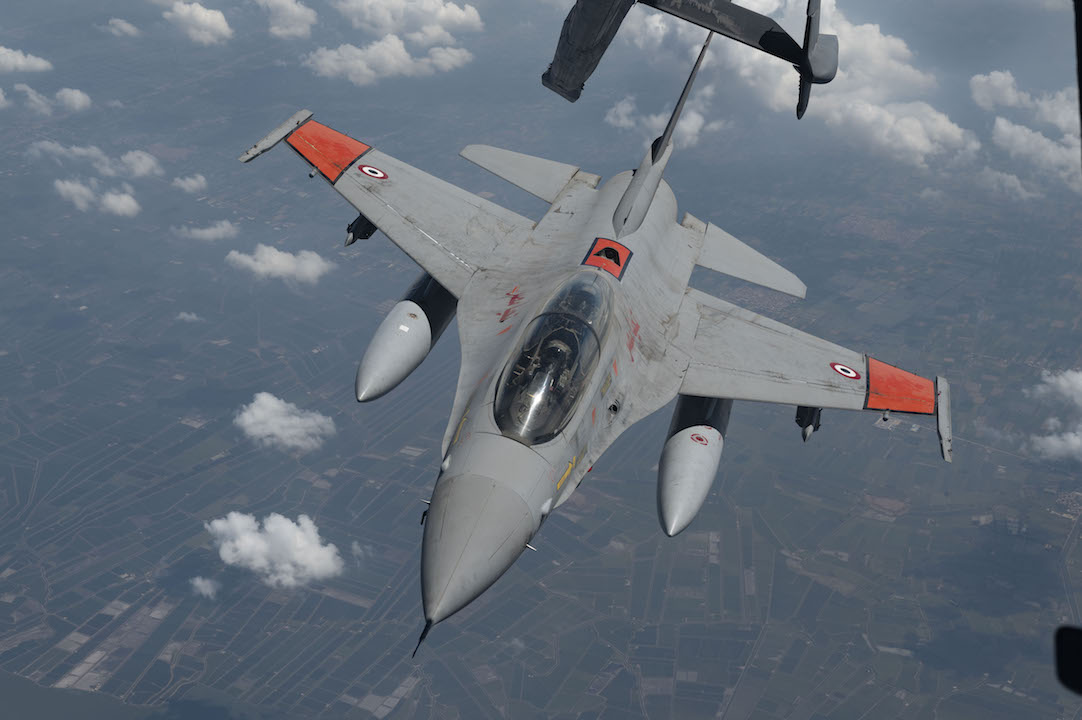Egypt goes shopping for pick and mix...
Egypt is in the market for new fighters, but budgetary constraints mean that they may have to settle for a mixture of new and second-hand aircraft.

Egypt's MiG-29M/M2 fighters are becoming more difficult to support and are now in need of replacement. Image: Egyptian Air Force
Before 1979, when then President Anwar Sadat signed a historic peace agreement with Israel, the Egyptian Air Force was primarily equipped with aircraft of Soviet design, some of them supplied by China after the loosening of ties with Russia in 1976.
Thereafter, though, Egypt increasingly diversified its combat aircraft acquisition, turning to the US and France to augment Soviet and Chinese aircraft deliveries. This policy allowed the Egyptian Air Force to maintain force size, and to become one of the numerically strongest air arms in the region, though the interoperability of its large and disparate fleet was increasingly called into question. Egypt now operates the world's fourth-largest fleet of Lockheed Martin F-16s, but operating these beside older Russian and Chinese supplied fighters was always problematic, and inhibited Egyptian air defence capabilities.
Egypt’s dual-track procurement approach continued until very recently, with Egypt ordering 24 Dassault Rafale F3-R aircraft in February 2015, with options for a further 12 aircraft, and, at almost the same time, also ordering 46 MiG-29M/M2 fighters.
Egypt then ordered 24 Sukhoi Su-35S fighters in 2018. Egypt took delivery of the MiGs from April 2017, but the Su-35S aircraft remained undelivered after the USA threatened to impose sanctions under the CAATSA (countering America's adversaries through sanctions act) regime.
In 2019, the US rejected an Egyptian request for 20 F-35As and Cairo returned to pursuing a follow-on Rafale buy, signing a contract (formally announced on May 3, 2021) with Dassault Aviation to purchase 30 more Rafales.
The new batch of Egyptian Rafales will be to F3-R standard, and will be equipped with active electronically scanned array (AESA) radar and probably the Thales’ Talios new-generation laser designator pod, laser homing Safran AASM modular air-to-ground weapons, and the MBDA SCALP cruise missile.
Dassault Aviation is to integrate a new data link that will allow the Rafale to communicate with US and NATO allies, and with Egypt’s remaining non-western fighters. Egypt is known to want MBDA’s Meteor long-range air-to-air missile for its Rafales, too, though this might attract US opposition since it might be thought to erode Israel’s regional ‘Qualitative Military Edge’ which the US is sworn to uphold. This is because Meteor outperforms the air-to-air weapons currently in service in Israel.
This consideration previously led to restrictions on the weapons that Egypt’s F-16s were allowed to carry, in particular preventing the supply of the active radar homing long-range AIM-120 AMRAAM missile. Instead, Egyptian F-16s were forced to rely on the semi-active radar homing AIM-7 Sparrow, and this in turn led Egypt to turn to the MiG-29M/M2 and Su-35S, and the R-77 active radar-homing beyond visual range air-to-air missiles they were compatible with.
The EAF will soon have a frontline element consisting of 11 tactical fighter wings. These will include 13 Squadrons of F-16s, two of MiG-29Ms, four of Rafales, two of Alpha Jets and two of Mirage 2000s. The Alpha Jets, Mirage 2000s, and some of the older F-16s will soon need replacing, however, and the MiG-29M/M2s are likely to become increasingly difficult to support and sustain in the face of US sanctions against Moscow in the wake of the war in Ukraine, which has dramatically affected Russian arms exports. The MiGs are already proving to be lacking in interoperability with Egypt’s Western-supplied fighters, command and control, and combat support aircraft, and have to be operated as an ‘air force within an air force’, which is becoming problematic as modern doctrine and tactics emphasise ever-closer co-operation and connectivity.
Egypt is, however, already ‘shopping around’ for new fighters.
Budgetary constraints mean that the solution to Egypt’s fighter gap will almost certainly involve a mix of new and second-hand aircraft. This could include an upgrade of some or all of the F-16s to F-16V standards, perhaps with a top-up buy of Block 70 or Block 72 F-16s (the new-build equivalent to the F-16V upgrade standard). There have been reports that “a significant upgrade” has been approved by the US administration, but details have not been revealed.
Perhaps more likely is a recapitalisation of the Dassault Mirage 2000 fleet through the acquisition of 12 aircraft retired by Qatar (Indonesia recently cancelled its $790 million procurement of these aircraft), and some of the UAE’s Mirage 2000-9s, when they are replaced by new Rafales, though 34 of the 56 or so survivors have reportedly been earmarked for supply to Morocco. This could leave Egypt with three quite different standards of Mirage 2000s – its own original Mirage 2000EMs and BMs, the ex-Qatari Mirage 2000-5EDAs and 5DDAs, and the Emirati Mirage 2000-9s.

In addition to upgrades and second-hand aircraft, Egypt hopes to acquire new-generation combat air platforms, looking in particular at the US Boeing F-15 and Europe’s Eurofighter Typhoon.
The US government has reportedly already approved plans to export the F-15EX Eagle II to Egypt, though there has not been a DSCA (Defense Security Co-operation Agency) notification to Congress. On March 15, 2022, General Kenneth McKenzie, the head of US Central Command (USCENTCOM), did, however, tell lawmaker during a session of the Senate Armed Services Committee in Washington, DC. That: “In the case of Egypt, I think we have good news - we’re going to provide them with F-15s,” McKenzie said, before adding that it had been "a long, hard slog" to finalise the sale.
In 2002, Israel pressured the US not to sell the legacy F-15C to Egypt as part of “a series of understandings" relating to US weapons sales to Egypt. But Israel has reportedly expressed support for the new deal, since it already has the more advanced Lockheed Martin F-35I Adir in service, and has itself requested the supply of 25 F-15EX aircraft in January 2023, of a total requirement for up to 50 of the new aircraft. Some reports suggest that there could be some ‘linkage’ between the supply of the F-15EX and the disposal of Egypt’s surviving MiG-29M/M2s – several of which were destroyed in Sudan last year. There is believed to have been a proposal that the MiGs (and their R-77 missiles) might be transferred to Ukraine, though Egypt may be resistant to such a course of action, which would significantly undermine its relations with Russia.
Egyptian president Abdel Fattah El-Sisi is reportedly determined to prevent any US efforts to blunt Egyptian capabilities in order to maintain Israel’s qualitative military edge, and to avoid an undue reliance on the US as a supplier, which could lead to a potential future vulnerability to US sanctions.
Any F-15EX purchase is therefore likely to be balanced by the purchase of a European fighter aircraft as well. There have already been reports that Egypt could eventually purchase the new Rafale F4, increasing the overall Egyptian Rafale fleet, 54 of which have been delivered or are on order to 72 or even 100 aircraft “depending on Egypt’s financial capacity.”
Though a further Rafale buy would bring commonality with Egypt’s existing fleet, there are some doubts as to Dassault’s ability to deliver aircraft in the required timescale. In view of its very full order book, Egypt is also understood to require certain capabilities beyond those offered by the Rafale (especially in terms of electronic attack and beyond visual range air-to-air combat), and has been looking at the Eurofighter Typhoon for some time.
The Eurofighter consortium allocates particular sales campaigns to individual ‘lead nations’, and Egypt has always been an Italian ‘responsibility’.
Initially, it was reported that Egypt was interested in second-hand Italian Tranche 1 aircraft, although Egyptian interest in the type is now believed to be focused on the latest standard EF-2000 aircraft, with AESA radar and the Meteor beyond-visual-range air-to-air missile (BVRAAM). These would be new-build aircraft assembled in Italy.
The Egyptian requirement is believed to be for 24-48 aircraft and they would form part of a wider $10-12 billion arms package from Italy. This would reportedly also include 24 Leonardo M346 Master training aircraft, 20-24 more AW-149 medium-lift/utility helicopters, as well as four FREMM heavy frigates (additional to the two already being discussed), 20 Falaj-II class patrol boats to be co-manufactured in Alexandria Shipyard, and a Telespazio radar-equipped military surveillance and reconnaissance satellite.
Stay up to date
Subscribe to the free Times Aerospace newsletter and receive the latest content every week. We'll never share your email address.

